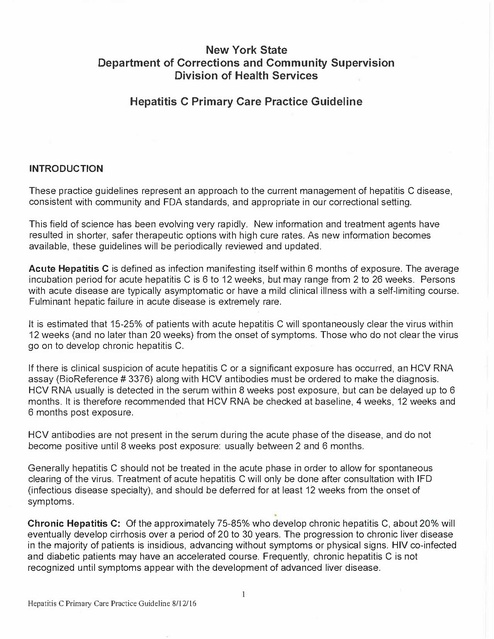Hepatitis C Primary Care Practice Guideline, NY DCCS, 2016
Download original document:

Document text

Document text
This text is machine-read, and may contain errors. Check the original document to verify accuracy.
New York State Department of Corrections and Community Supervision Division of Health Services Hepatitis C Primary Care Practice Guideline INTRODUCTION These practice guidelines represent an approach to the current management of hepatitis C disease, consistent with community and FDA standards, and appropriate in our correctional setting. This field of science has been evolving very rapidly. New information and treatment agents have resulted in shorter, safer therapeutic options with high cure rates. As new information becomes available, these guidelines will be periodically reviewed and updated. Acute Hepatitis C is defined as infection manifesting itself within 6 months of exposure. The average incubation period for acute hepatitis C is 6 to 12 weeks, but may range from 2 to 26 weeks. Persons with acute disease are typically asymptomatic or have a mild clinical illness with a self-limiting course. Fulminant hepatic failure in acute disease is extremely rare. It is estimated that 15-25% of patients with acute hepatitis C will spontaneously clear the virus within 12 weeks (and no later than 20 weeks) from the onset of symptoms. Those who do not clear the virus go on to develop chronic hepatitis C. If there is clinical suspicion of acute hepatitis C or a significant exposure has occurred, an HCV RNA assay (BioReference # 3376) along with HCV antibodies must be ordered to make the diagnosis. HCV RNA usually is detected in the serum within 8 weeks post exposure, but can be delayed up to 6 months. It is therefore recommended that HCV RNA be checked at baseline, 4 weeks, 12 weeks and 6 months post exposure. HCV antibodies are not present in the serum during the acute phase of the disease, and do not become positive until 8 weeks post exposure: usually between 2 and 6 months. Generally hepatitis C should not be treated in the acute phase in order to allow for spontaneous clearing of the virus. Treatment of acute hepatitis C will only be done after consultation with IFD (infectious disease specialty), and should be deferred for at least 12 weeks from the onset of symptoms. Chronic Hepatitis C: Of the approximately 75-85% who develop chronic hepatitis C, about 20% will eventually develop cirrhosis over a period of 20 to 30 years. The progression to chronic liver disease in the majority of patients is insidious, advancing without symptoms or physical signs. HIV co-infected and diabetic patients may have an accelerated course. Frequently, chronic hepatitis C is not recognized until symptoms appear with the development of advanced liver disease. Hepatitis C Primary Care Practice Guideline 8/12/16

